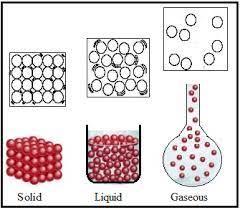
revision on unit 1 lesson 1
Quiz by Doaa Sobhy
Feel free to use or edit a copy
includes Teacher and Student dashboards
Measure skillsfrom any curriculum
Tag the questions with any skills you have. Your dashboard will track each student's mastery of each skill.
- edit the questions
- save a copy for later
- start a class game
- automatically assign follow-up activities based on students’ scores
- assign as homework
- share a link with colleagues
- print as a bubble sheet
- Q1
1-Which of the following statement is the best define the density of a substance?
b. The area per unit volume of a substance.
a. The mass per unit volume of a substance.
c. The weight per unit mass of a substance.
60s - Q2
The densities of water and a certain oil are given in the image below. An object is found to sink in the oil but float on water. What can be assumed about the density of the object?
Its density is greater than 0.9 g/cm3 but less than 1.0 g/cm3.
Its density is less than 0.9 g/cm3 but greater than 1.0 g/cm3.
Its density is less than 0.9 g/cm3 and less than 1.0 g/cm3.
Its density is greater than 0.9 g/cm3 and greater than 1.0 g/cm3.
60s - Q3
image below shows a tank of water into which various objects have been placed. Which of the following statements might explain what is observed?
The stone and iron nail have densities greater than the density of water.
The ice cube and cork have densities greater than the density of water.
The stone and iron nail have densities smaller than the density of water.
30s - Q4
Balloons filled with hydrogen or helium will rise, but balloons filled with oxygen or chlorine will not. Which statement explains why this happens?
Hydrogen and helium are less dense than air, but oxygen and chlorine are denser than air.
Hydrogen and oxygen are less dense than air, but helium and chlorine are denser than air.
Hydrogen and oxygen are denser than air, but helium and chlorine are less dense than air.
Helium and oxygen are denser than air, but hydrogen and chlorine are less dense than air.
60s - Q5
The diagram below shows a series of beakers containing different liquids as well as the densities of these liquids. A small sample of lithium has a density of 0.5 g/cm3.Will the sample sink or float when placed in beaker B?
Float
Sink
60s - Q6
The temperature at which matter changes from the solid state to the liquid state is known as its…………. point.
Melting
Boiling.
Freezing
Critical
60s - Q7
In order to shape copper, the metal must first be heated to a temperature between 400∘C and 700∘C.Why must the metal be heated first?
To help soften the metal.
To help harden the metal.
To turn the metal into a gas.
30s - Q8
Why are cooking pots and pans made from aluminum and not from plastic?
Aluminum is light, whereas plastic is heavy.
Aluminum is a better conductor of thermal energy than plastic.
Aluminum is a better electrical conductor than plastic.
30s - Q9
An engineer wants to protect ironwork from rusting. Which of the following options would not help prevent the formation of rust ?
Painting the iron.
Keeping the iron warm.
Coating the iron with grease.
30s - Q10
As the temperature increases, what is the correct order in which the substances shown below become gradually softer and easier to shape?
Rubber ball, bar of metal, lump of sulfur.
Lump of sulfur, rubber ball, bar of metal.
Rubber ball, lump of sulfur, bar of metal.
Bar of metal, rubber ball, lump of sulfur.
30s